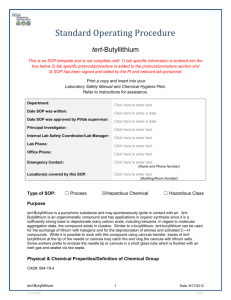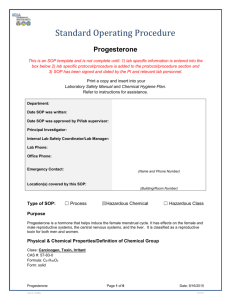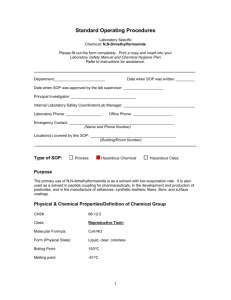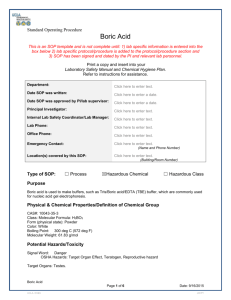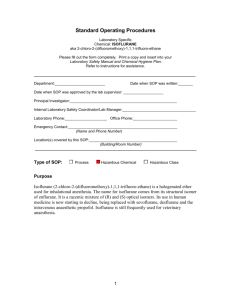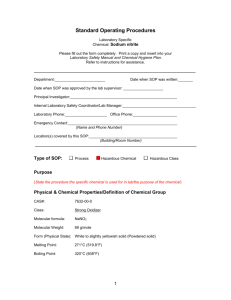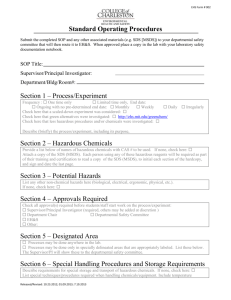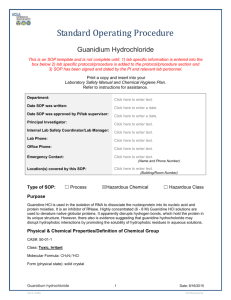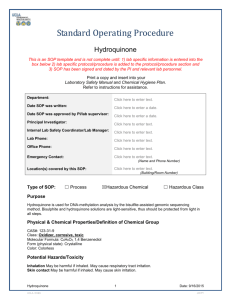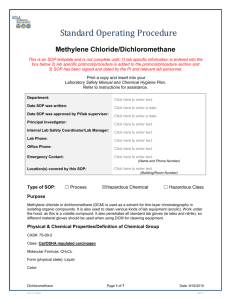Oxygen - UCLA David Geffen School of Medicine Laboratory Safety
advertisement
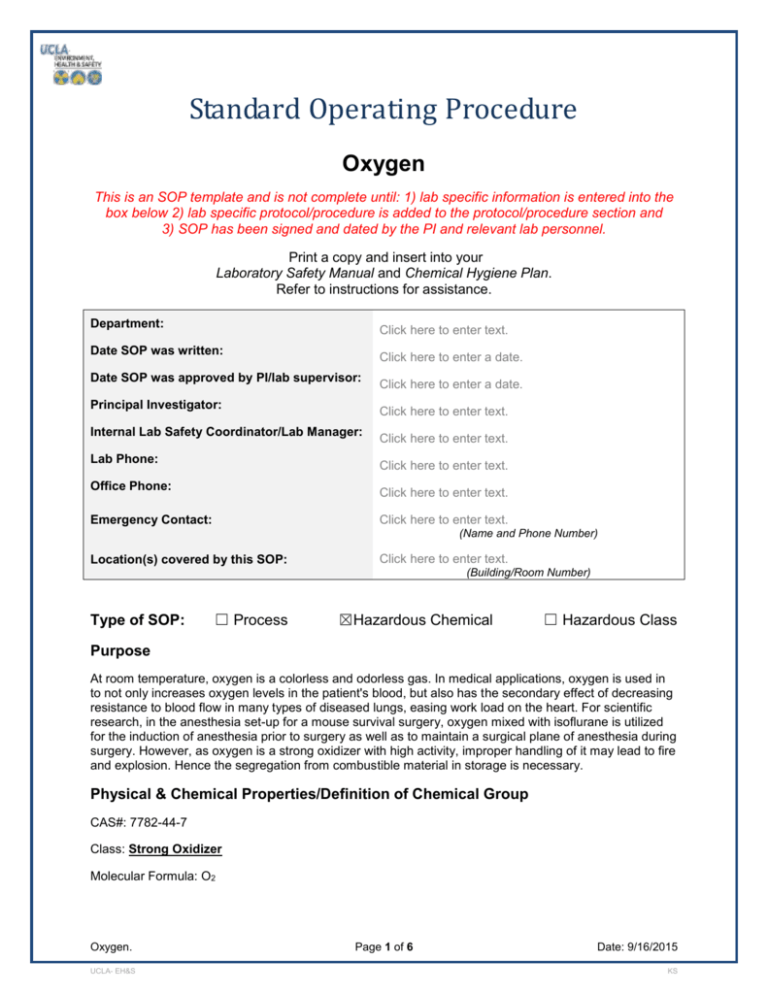
Standard Operating Procedure Oxygen This is an SOP template and is not complete until: 1) lab specific information is entered into the box below 2) lab specific protocol/procedure is added to the protocol/procedure section and 3) SOP has been signed and dated by the PI and relevant lab personnel. Print a copy and insert into your Laboratory Safety Manual and Chemical Hygiene Plan. Refer to instructions for assistance. Department: Click here to enter text. Date SOP was written: Click here to enter a date. Date SOP was approved by PI/lab supervisor: Principal Investigator: Click here to enter text. Internal Lab Safety Coordinator/Lab Manager: Lab Phone: Click here to enter a date. Click here to enter text. Click here to enter text. Office Phone: Click here to enter text. Emergency Contact: Click here to enter text. (Name and Phone Number) Location(s) covered by this SOP: Click here to enter text. (Building/Room Number) Type of SOP: ☐ Process ☒Hazardous Chemical ☐ Hazardous Class Purpose At room temperature, oxygen is a colorless and odorless gas. In medical applications, oxygen is used in to not only increases oxygen levels in the patient's blood, but also has the secondary effect of decreasing resistance to blood flow in many types of diseased lungs, easing work load on the heart. For scientific research, in the anesthesia set-up for a mouse survival surgery, oxygen mixed with isoflurane is utilized for the induction of anesthesia prior to surgery as well as to maintain a surgical plane of anesthesia during surgery. However, as oxygen is a strong oxidizer with high activity, improper handling of it may lead to fire and explosion. Hence the segregation from combustible material in storage is necessary. Physical & Chemical Properties/Definition of Chemical Group CAS#: 7782-44-7 Class: Strong Oxidizer Molecular Formula: O2 Oxygen. UCLA- EH&S Page 1 of 6 Date: 9/16/2015 KS Form (physical state): Gas Color: Clear, Colorless Boiling point: -183OC Potential Hazards/Toxicity May cause eye, skin, and respiratory tract irritation. Contact with rapid expanding gas could cause burns or frostbite. Contact with combustible material may cause a fire. Personal Protective Equipment (PPE) Respiratory Protection Use a properly fitted, air-purifying or air-fed respirator complying with an approved standard if a risk assessment indicates this is necessary. Respirators should be used only under any of the following circumstances: As a last line of defense (i.e., after engineering and administrative controls have been exhausted). When Permissible Exposure Limit (PEL) has exceeded or when there is a possibility that PEL will be exceeded. Regulations require the use of a respirator. An employer requires the use of a respirator. There is potential for harmful exposure due to an atmospheric contaminant (in the absence of PEL) As PPE in the event of a chemical spill clean-up process Lab personnel intending to use/wear a respirator mask must be trained and fit-tested by EH&S. This is a regulatory requirement. (https://www.ehs.ucla.edu/ep/ih/resp) Hand Protection Nitrile gloves are recommended. NOTE: Consult with your preferred glove manufacturer to ensure that the gloves you plan on using are compatible with oxygen. Refer to glove selection chart from the links below: http://www.ansellpro.com/download/Ansell_8thEditionChemicalResistanceGuide.pdf OR http://www.allsafetyproducts.com/glove-selection-chart-chemical-breakthrough-ratings.html OR http://www.showabestglove.com/site/default.aspx OR http://www.mapaglove.com/ Eye Protection ANSI approved safety glasses or goggles. Skin and Body Protection Lab coats should be worn. These laboratory coats must be appropriately sized for the individual and be buttoned to their full length. Laboratory coat sleeves must be of a sufficient length to prevent skin exposure while wearing gloves. Full length pants and close-toed shoes must be worn at all times by all individuals that are occupying the laboratory area. The area of skin between the shoe and ankle should not be exposed. Oxygen. UCLA- EH&S Page 2 of 6 Date: 9/16/2015 KS Hygiene Measures Avoid contact with skin, eyes and clothing. Wash hands before breaks and immediately after handling the product. Engineering Controls Use in a well-ventilated area. First Aid Procedures If inhaled If inhaled, remove to fresh air. If not breathing, give artificial respiration. Get medical attention. In case of skin contact Frostbite may occur, try to warm up the frozen tissues and seek medical attention. In case of eye contact Immediately flush eyes with plenty of water for at least 15 minutes, occasionally lifting the upper and lower eyelids. Get medical attention immediately. Special Handling and Storage Requirements Handling High pressure gas. Do not puncture or incinerate container. Use equipment rated for cylinder pressure. Close valve after each use and when empty. Store in tightly-closed container. Avoid contact with combustible materials. Protect cylinders from physical damage; do not drag, roll, slide, or drop. Use a suitable hand truck for cylinder movement. Storage Keep container tightly closed. Keep container in a cool, well-ventilated area. Separate from acids, alkalis, reducing agents and combustibles. Cylinders should be stored upright, with valve protection cap in place, and firmly secured to prevent falling or being knocked over. Cylinder temperatures should not exceed 52 °C (125 °F). Store at least 20 feet away from flammable compressed gas cylinders. Must be secured with double chains, 1/3 from the top and bottom. Spill and Accident Procedure Chemical Spill Dial 911 and x59797 Spill – Assess the extent of danger. Help contaminated or injured persons. Evacuate the spill area. Avoid breathing vapors. If possible, confine the spill to a small area using a spill kit or absorbent material. Keep others from entering contaminated area (e.g., use caution tape, barriers, etc.). Small (<1 L) – If you have training, you may assist in the clean-up effort. Use appropriate personal protective equipment and clean-up material for chemical spilled. Double bag spill waste in clear plastic bags, label and take to the next chemical waste pick-up. Large (>1 L) – Dial 911 (or 310-825-1491 from cell phone) and EH&S at x59797 for assistance. Chemical Spill on Body or Clothes – Remove clothing and rinse body thoroughly in emergency shower for at least 15 minutes. Seek medical attention. Notify supervisor and EH&S at x59797 immediately. Chemical Splash Into Eyes – Immediately rinse eyeball and inner surface of eyelid with water from the emergency eyewash station for 15 minutes by forcibly holding the eye open. Seek medical attention. Notify supervisor and EH&S at x59797 immediately. Oxygen. UCLA- EH&S Page 3 of 6 Date: 9/16/2015 KS Medical Emergency Dial 911 or x52111 Life Threatening Emergency, After Hours, Weekends And Holidays – Dial 911 (or 310-825-1491 from cell phone) or contact the Ronald Reagan UCLA Medical Center (emergency room) directly at x52111 (located at 757 Westwood Plaza, enter from Gayley Avenue). Note: All serious injuries must be reported to EH&S at x59797 within 8 hours. Non-Life Threatening Emergency – Go to the Occupational Health Facility (OHF), x56771, CHS room 67-120 (This is on the 6th floor, 7th corridor, room 120. Enter through the School of Dentistry on Tiverton Drive and proceed to the “O” elevator to the 6th floor.)Hours: M - F, 7:30 a.m. to 4:30 p.m. At all other times report to Ronald Regan UCLA Medical Center (emergency room) at x52111. Note: All serious injuries must be reported to EH&S at x59797 within 8 hours. Needle stick/puncture exposure (as applicable to chemical handling procedure) – Wash the affected area with antiseptic soap and warm water for 15 minutes. For mucous membrane exposure, flush the affected area for 15 minutes using an eyewash station. Page the needle stick nurse by dialing 231 from a campus phone, enter 93333 when prompted and then enter your extension. Hours: M – F, 8:00 a.m. to 4:00 p.m. At all other times report to Ronald Regan UCLA Medical Center (emergency room) at x52111. Note: All needle stick/puncture exposures must be reported to EH&S at x59797 within 8 hours. Decontamination/Waste Disposal Procedure When the oxygen compressed gas cylinder is empty, remove any attachments from the valve, cap the cylinder, and mark “empty” on the cylinder. General hazardous waste disposal guidelines: Label Waste Affix an on-line hazardous waste tag on all waste containers using the WASTe Online Tag Program https://ehs.ucop.edu/waste as soon as the first drop of waste is added to the container Store Waste Store hazardous waste in closed containers, in secondary containment and in a designated location Double-bag dry waste using transparent bags https://www.ehs.ucla.edu/hazwaste/management/containers Waste must be under the control of the person generating & disposing of it Dispose of Waste Dispose of regularly generated chemical waste within 90 days Call EH&S at x61887 for questions Empty Containers o Dispose as hazardous waste if it once held extremely hazardous waste (irrespective of the container size) https://www.ehs.ucla.edu/hazwaste/types/extremely-hazardous o Consult waste pick-up schedule https://www.ehs.ucla.edu/hazwaste/management/pick-ups Prepare for transport to pick-up location Check on-line waste tag Write date of pick-up on the waste tag Use secondary containment Safety Data Sheet (SDS) Location Online SDS can be accessed at http://msds.ehs.ucla.edu. Protocol/Procedure Oxygen. UCLA- EH&S Page 4 of 6 Date: 9/16/2015 KS Amount Covered Oxygen is used at 1 LPM for about 5 minutes (during induction) and at 0.5 LPM for the remainder of surgery (about 1.5 hours) Temperature Covered 18-25 C Below is the procedure used for mouse survival surgery. Stereotaxic surgery 1. Before starting surgery, remove cover from oxygen tank and replace it with an oxygen regulator. 2. While wearing a laboratory coat and nitrile gloves, use an isoflurane anti-spill device to pour isoflurane into the vaporizer. 3. Make sure the opening is properly closed once the pouring is done. 4. Make sure the amount of oxygen is sufficient to last until the end of the procedure. 5. Place the animal in the induction chamber and close the lid tightly. 6. Open the oxygen valve and set the oxygen flow to 1 LPM using the flowmeter control knob. 7. Turn on the vaporizer and adjust the isoflurane concentration to 4-5%. 8. When the mouse is in a moderately deep plane of anesthesia, remove it from the induction chamber and close the lid. 9. Connect the nose of the mouse to the stereotaxic frame’s mouse head holder and open the gas flow to the nose. 10. Adjust the Oxygen flow to 0.5 LPM and reduce the isoflurane concentration to 1-3% (to maintain surgical plane of anesthesia). The percentage varies by mouse. 11. Monitor the depth of anesthesia throughout the procedure by toe pinch and looking for breathing patterns. 12. When finished with the procedure, shut off the vaporizer and the oxygen tank. 13. Return the mouse to its cage and place it over a heat pad. Monitor the mouse until it regains full consciousness. 14. Before leaving the room, make sure everything was properly turned off. Remove the oxygen regulator and cap the cylinder. NOTE Any deviation from this SOP requires approval from PI. Documentation of Training (signature of all users is required) Prior to conducting any work with oxygen, designated personnel must provide training to his/her laboratory personnel specific to the hazards involved in working with this substance, work area decontamination, and emergency procedures. The Principal Investigator must provide his/her laboratory personnel with a copy of this SOP and a copy of the SDS provided by the manufacturer. The Principal Investigator must ensure that his/her laboratory personnel have attended appropriate laboratory safety training or refresher training within the last one year. Principal Investigator SOP Approval Print name __________________________Signature___________________________ Approval Date: Oxygen. UCLA- EH&S Page 5 of 6 Date: 9/16/2015 KS I have read and understand the content of this SOP: Name Signature Date Click here to enter text. Click here to enter a date. Click here to enter text. Click here to enter a date. Click here to enter text. Click here to enter a date. Click here to enter text. Click here to enter a date. Click here to enter text. Click here to enter a date. Click here to enter a date. Click here to enter a date. Click here to enter text. Click here to enter text. Click here to enter text. Click here to enter a date. Click here to enter text. Click here to enter a date. Click here to enter text. Click here to enter a date. Click here to enter text. Click here to enter a date. Click here to enter a date. Click here to enter a date. Click here to enter text. Click here to enter text. Click here to enter text. Click here to enter a date. Click here to enter text. Click here to enter a date. Oxygen. UCLA- EH&S Page 6 of 6 Date: 9/16/2015 KS


